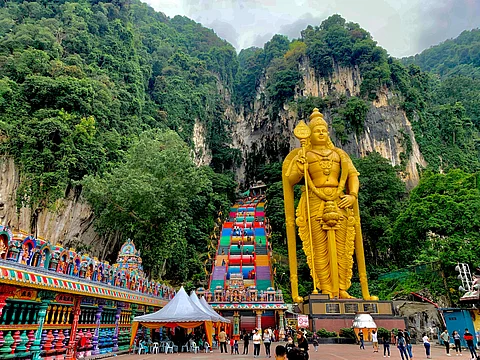
- Destinations
- Experiences
- Stay
- What's new
- Celebrating People
- Responsible Tourism
- CampaignsCampaigns
- Subscribe
- Buy Now

Rising dramatically from the landscape about 14 km north of Kuala Lumpur, Batu Caves is one of Malaysia’s most iconic landmarks. Known for its towering golden statue of Hindu deity Murugan, steep flight of rainbow-coloured steps, and a labyrinth of limestone caves, Batu Caves is not just a tourist attraction—it is a living, breathing Hindu shrine and a vital cultural symbol for the Tamil community in Malaysia. Whether you're a spiritual seeker, culture enthusiast, or adventurer, a visit here promises a memorable experience.
Batu Caves gets its name from the Sungai Batu (Batu River) that flows past the hill. The caves are around 400 million years old, but they became a place of worship only in the late 19th century. In 1891, Indian trader K. Thamboosamy Pillai dedicated the site to Murugan, the Hindu god of war, and installed a consecrated statue. Since then, Batu Caves has grown to become the most important Hindu shrine outside India, especially during the Thaipusam festival.
The staircase leading to the main Temple Cave is perhaps the most iconic feature of Batu Caves. Painted in bright hues during a recent restoration project, the 272 steps offer a colourful climb and panoramic views of the surrounding areas. Take your time—and be prepared for plenty of photo stops.
Standing at an impressive 42.7 m (140 ft), the golden statue of Hindu deity Murugan at the foot of the stairs is the tallest of its kind in the world. It's a stunning symbol of devotion and artistry, and a must-see for every visitor.
Once you reach the top, you will find yourself in the vast main cavern, home to several shrines dedicated to the deity. The natural rock formations overhead, along with shafts of sunlight streaming through openings, create a magical atmosphere that feels ancient and alive.
Located halfway up the staircase, the Dark Cave offers guided educational tours that delve into the ecology and history of the limestone caves. This conservation site is home to rare species, including the endangered Trapdoor spider. Adventure tours, involving crawling and exploring hidden chambers, are also available for the more daring.
On the right-hand side of the main entrance, the Ramayana Cave narrates the story of deity Rama through a series of colourful statues and murals. It’s a peaceful, less crowded part of the complex, ideal for those who want to explore more leisurely.
Bring water and wear comfortable shoes for the climb.
Keep a respectful distance from the monkeys; do not feed them.
If you’re planning a visit to the Dark Cave, wear closed shoes and bring a flashlight for added comfort.
Early mornings are also perfect for catching beautiful light for photography.
Batu Cave Villa: A cultural complex with beautiful gardens and a small museum.
Royal Selangor Visitor Centre: Learn about Malaysia’s famed pewter industry.
Kanching Waterfalls: A refreshing spot for a hike and a dip, just a short drive away.
Early morning (before 9 AM) is the best time to visit Batu Caves to avoid crowds and the afternoon heat. If you are interested in witnessing a major cultural spectacle, visit during Thaipusam (usually between January and February). However, be prepared for huge crowds and road closures.
As Batu Caves is a religious site, modest clothing is required. Both men and women should cover their shoulders and knees. Sarongs can be rented at the entrance if needed.
By Train: The KTM Komuter train service from Kuala Lumpur Sentral Station to Batu Caves station is the easiest and cheapest option. The trip takes about 30-40 minutes.
By Road: Alternatively, you can take a taxi or use a ride-hailing app for affordable and convenient transportation.
By Tour: Many city tours include Batu Caves as a half-day trip, often combined with other attractions around Kuala Lumpur.
